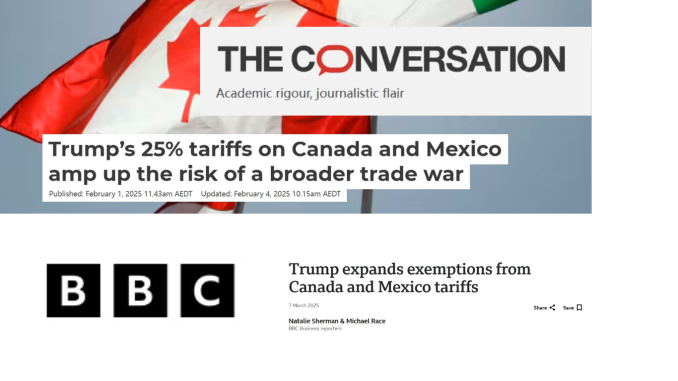
In Short
This article will explore the systematic differences in the logic of news reporting on U.S. imposing tariffs on Canada and Mexico between two representative media organizations, the BBC and The Conversation.
By analyzing their different approaches in terms of accuracy mechanisms, structural design, visual narratives, and advertising strategies, we can better understand the fundamental differences between traditional media and the new academic-journalistic hybrid model, and how these differences affect reader experience and information delivery.
Biographical Survey of BBC News Online and The Conversation
- BBC News Online was launched in November 1997 as part of the British Broadcasting Corporation (“BBC News,” n.d.).
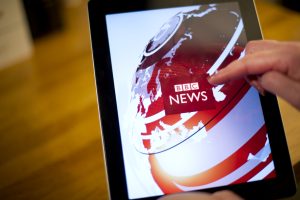
- The Conversation, a non-profit news platform, was launched in Australia in March 2011 by Andrew Jaspan and Jack Rejtman, with a vision to bridge academic expertise and journalism (The Conversation, n.d.-a).
- The BBC is primarily funded by television license fees paid by UK households, a model set by the government and approved by Parliament (“BBC Annual Report and Accounts,” n.d.; “BBC Charter and Agreement,” n.d.).
- The Conversation, however, relies on a mix of funding from universities, government grants, and reader donations (The Conversation, n.d.-b).
- BBC News Online is a global powerhouse, projected to reach 450 million viewers worldwide per week in 2024, with BBC News specifically accounting for 414 million of those (“BBC’s Global Audience Measurement Report,” 2024).
- The Conversation, meanwhile, envisions universities as “huge newsrooms,” funding from Universities and Government (The Conversation, n.d.-a).
User Analysis and Target Markets
BBC News Online caters to a broad, demographically diverse global audience, including UK residents (funded by license fees) and international readers seeking reliable, balanced reporting.
The Conversation, however, targets a niche, educationally affluent audience. According to its 2024 media kit, key demographics include professionals in academia (16%), education (15%), healthcare (12%), and government/policy (10%), alongside CEOs, researchers, and policymakers.
Its daily newsletter boasts 194,000 subscribers and an exceptional 44.4% open rate (double the industry average), reflecting high engagement among intellectually curious users.
“Digital native news platforms tend to link to external authoritative resources, while traditional media place more emphasis on internal content citations” (Harmer & Southern, 2020). Therefore, The Conversation is more based on the concept of open knowledge circulation.
Accuracy, Sources and Credibility

The BBC provides accuracy by attributing information to official sources and eyewitnesses in the text, e.g. “White House officials said…”. The credibility of the BBC article depends largely on the BBC’s reputation. Traditional news articles like the BBC do not typically use formal citations or hyperlinks to external sources in the narrative; instead, sources are cited in prose, e.g. “According to a White House press release”. This means that readers must trust the reporting.
The Conversation article demonstrates transparency by citing sources extensively through hyperlinks. In fact, it reads almost like a light academic article with embedded citations. Throughout the article, the author links specific claims to external evidence or reporting: for example, Trump’s statement that he will “introduce a new set of 25% tariffs on February 1st.”
The Conversation article contains dozens of hyperlinks (about 20-25) to various news outlets, official data sources.

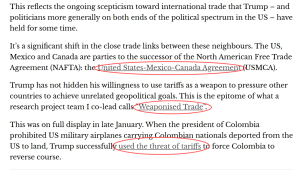
This practice is consistent with the principle that “interactivity is at the heart of online journalism, just as sound is at the heart of radio,” and one of the most basic interactive tools is the hyperlink, which users can click to view related information.
By providing these links, the Conversation article enhances its credibility and depth, readers can click to verify facts or explore more details. In fact, research has found that extensive hyperlinks can increase users’ trust in online news by providing transparency.
Wagner supports each assertion with sources that readers can consult, embodying the journalism philosophy of “showing, not just telling.” This approach reflects the academic roots of The Conversation (much like online articles with footnotes). This is a different but effective path to accuracy: rather than expecting readers to gain trust solely from brand authority, articles invite readers to check the source themselves, a key aspect of online news verification.
“The use of hyperlinks is a digital advantage that enhances the transparency and credibility of news, especially connections with academic and policy sources”
(Harmer & Southern, 2020). This explains why The Conversation can better meet the modern audience’s demand for “verifiability”.
Structure and Scannability
BBC articles emphasize the immediacy and information concentration of the news itself. The logical structure is relatively simple and linear. They are usually organized in the form of short sentences and very short paragraphs. This design meets the reader’s need to quickly grasp the main points of the news and ensure that the key content can be effectively received even if it is browsed.
The Conversation provides in-depth analysis and interpretation of content, with a longer length. Therefore, it uses more obvious auxiliary navigation elements, such as clear subtitles, emphasized fonts, and moderate paragraph length.
The Conversation guides readers to quickly locate the information fragments they are interested in through the block prompts of subtitles and the visual contrast of the layout. This structure itself also reflects the good online writing practices recommended by the “The Online Journalism Handbook”: presenting and emphasizing the key points through “blocks” to reduce the cognitive burden of users scanning and understanding information. (Bradshaw, 2023)
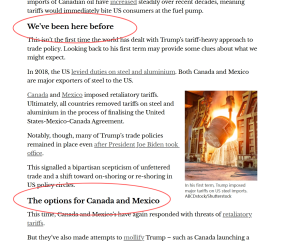
The logical relationship behind these two practices also clearly reflects the interactive relationship between the positioning of their respective news products and the reader’s behavior pattern.
The BBC is suitable for readers who need to quickly obtain basic news information, while The Conversation is aimed at users who pursue in-depth understanding, tend to read carefully and browse selectively.
Visual narrative
Al-Hamami (2019) pointed out: “One of the most important multimedia features of the BBC website is the integration of elements such as text, images, sound and video to enhance user interactivity and immersion” (Al-Hamami, 2019). Therefore, the BBC places multimedia at the top or key positions of the article to construct a powerful way of presenting information, which is a logic of “attracting attention and instant dissemination”.
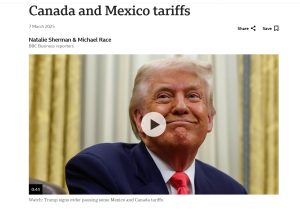
This is also a trend of change in the form of news narrative. Song (2018) pointed out in his study of audio and video narratives produced by journalism students:
“News creation through multimodal methods has enabled news producers to form a richer and more concrete narrative expression in the digital age”
(Song, 2016). The goal is to make news more intuitive and communicative.

The Conversation adopts a relatively concise, text-centric visual design logic. The purpose of this design is to “reduce visual interference and highlight text content” so that readers can focus on analytical and explanatory information. Fowler-Watt (2016) emphasized in his talk about journalism education: “Although the digital age emphasizes multimedia, original narrative is still the core of news, which requires clear structure and rigorous argumentation” (Fowler-Watt, 2016). “The Conversation” emphasizes in-depth analysis and professional interpretation.
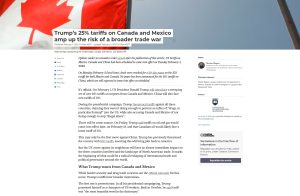
This difference also reflects the difference in the positioning of different audiences. “The Conversation” mainly attracts audiences who “focus on in-depth reading and rational analysis”, and its visual presentation logic is more similar to academic publications. Koivunen-Niemi & Masoodian (2019) proposed: “Simple and clear timeline visualization design helps users understand complex narrative structures” and emphasized that reducing visual noise helps “deep processing of content” (Koivunen-Niemi & Masoodian, 2019).

BBC emphasizes that “multimedia elements promote the efficiency of news dissemination”. Palacios et al. (2016) pointed out in their analysis of news apps in many countries: “News organizations continue to experiment with content and formats through visual and interactive functions to adapt to the fast-paced reading needs of mobile terminals” (Palacios et al., 2016). Therefore, the design logic of BBC is precisely high-frequency and highly interactive news consumption behavior.
“News organizations introduce multimedia design through interactive narrative platforms to increase the attractiveness of information and audience engagement”
(Otero-González & Vázquez Herrero, 2023). Therefore, “The Conversation” does not completely exclude visualization, but flexibly adjusts according to the type of article.
Advertising strategy
For commercial interests, BBC’s international station must introduce multiple advertising content, especially at the top of the page, and even insert advertising modules inside the article.
The existence of advertising itself is fundamentally in conflict with readers’ coherent and smooth reading experience of the content. Advertising is likely to distract users’ attention and break the continuity of content reading, thereby reducing the information transmission effect of the article and readers’ satisfaction.
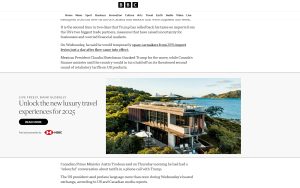
The non-profit model of The Conversation determines that it does not need to rely on advertising revenue, which allows its page design to be more purely content-oriented, avoiding the interference caused by commercial advertisements, allowing users to read more attentively and smoothly.
Therefore, the economic operation model of the media determines its advertising layout strategy, and the advertising layout directly shapes the overall quality and concentration of the user experience. This relationship is systemic and interdependent, not limited to the surface level of web design, but goes deep into the core logical connection between media industry structure and user experience.
In conclusion
BBC News adopts the traditional media model, focusing on immediacy and a wide global audience, providing short and direct news reports, but with advertisements. The Conversation adopts an academic-news hybrid model, targeting highly educated professionals, providing in-depth analysis, using a large number of hyperlinks to enhance transparency and credibility, with a more complex structure but clear navigation elements, text-centric and almost no advertisements, providing readers with a more focused reading experience.
Reference
Al-Hamami, H. (2019). The digital electronic media methods in communication with the public: BBC website as a model. New Media and Mass Communication, 81, pp. 12–14.
Fowler-Watt, K. (2016). It’s the story that matters! Teaching journalism’s storytellers. Journalism Education, 5(2), pp. 3–5.
Gillen, J., & Passey, D. (2011). Digital literacies in the making: Schools producing news with the BBC. Nordic Journal of Digital Literacy, 6, 37–51.
Harmer, E., & Southern, R. (2020). Is digital news really that digital? An analysis of how online news sites in the UK use digital affordances to enhance their reporting. Journalism Studies, 21(16), 2234–2248. p. 2240. [Access: https://doi.org/10.1080/1461670x.2020.1831397]
Koivunen-Niemi, L., & Masoodian, M. (2019). Visualizing narrative patterns in online news media. Multimedia Tools and Applications, 79, 919–946. p. 921、932.
Otero-González, I., & Vázquez Herrero, J. (2023). Open and commercial tools to generate a digital interactive story in journalism: Systematic review and features analysis. New Review of Hypermedia and Multimedia, 29, 36–55. p. 43. [Access: https://doi.org/10.1080/13614568.2023.2175041]
Palacios, M., Barbosa, S., da Silva, F. F., & da Cunha, R. (2016). Mobile journalism and innovation: A study on content formats of autochthonous news apps for tablets. In Journalism and Ethics. “App Structure Analysis”,p. 197–200.
Bradshaw, P. (2023). The online journalism handbook : Skills to survive and thrive in the digital age. Taylor & Francis Group.
Song, Y. (2016). Multimedia news storytelling as digital literacies. Journalism, 19(6), 837–859. https://doi.org/10.1177/1464884916648093
The Conversation media Kit https://cdn.theconversation.com/static_files/files/3145/Media_kit_2024.pdf?1710384909
BBC History https://www.bbc.co.uk/historyofthebbc
BBC Charter and Agreement Governance details https://www.bbc.com/aboutthebbc/governance/charter
BBC Annual Report and Accounts Financial overview https://www.bbc.com/aboutthebbc/reports/annualreport
History and expansion of the Conversation website https://en.wikipedia.org/wiki/The_Conversation_(website)
About us The Conversation’s mission and funding https://theconversation.com/au/who-we-are
Who funds The Conversation List of funding partners https://theconversation.com/who-funds-the-conversation-13921
BBC Global Audience Measurement Report https://www.bbc.com/mediacentre/2024/bbc-global-audience-measure
The Conversation US Funding transparency https://theconversation.com/us/who-we-are




Be the first to comment